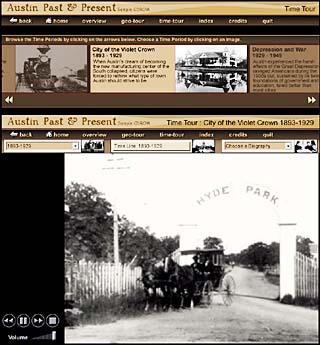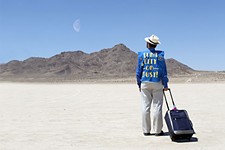From 380 Angles
Karen Kocher's multimedia 'Austin Past & Present' tells hundreds of stories in almost as many ways
By Michael May, Fri., Aug. 15, 2003

The story of Austin could never be told from start to finish. Sure, Austin is a place moving through time, and that's a natural progression, but try and fashion that into a narrative. Think about it. As you sit and read this article, you are sharing this moment in time with more than half a million other Austinites. The minutes you share will be as varied as the people who share the city. Some will be just as mundane as yours and not worth recording -- someone sits on a park bench and daydreams, another sings at their local church, a group gathers to swim at Barton Springs. But it's also possible that during your moment of repose, a major event is brewing that will affect us all. A community gets angry enough to become organized. A new highway is planned. A hurricane brews over the Atlantic. The Democrats get bored with Albuquerque and come home. Every day there are events that change the political, social, and natural fabric of our city.
You can see the challenge that documentary filmmaker Karen Kocher faced when she decided to tackle the entire history of Austin. A lover of minute details and forgotten heroes, Kocher couldn't bring herself to distill Austin's past into just one story. "When you try and create a dramatic structure out of something this rich and varied," she says, "you either end up with a 10-part Ken Burns-type series or you end up with all this great stuff on the cutting-room floor."
The solution that Kocher found is quintessentially Austin: a multimedia presentation with literally hundreds of stories titled Austin Past & Present. "This way I can find a place for all those things that work together to define Austin," she says. Austin Past & Present, which is scheduled to be released early next year, offers countless paths for exploring the city's history. A timeline. A list of biographies. Interactive maps of each area of Austin illustrated by Sam Hurt. And all of the parts are interwoven together to facilitate compulsive browsing. A click on the timeline at 1893-1929, titled "City of the Violet Crown," brings up a short documentary of the rise and fall of the first dam on the Colorado. Pull-down menus along the top of the screen provide access to more photos and stories and a list of a dozen or so movers and shakers from that era. Maps provide stories of different communities and their forgotten or famous inhabitants.
Take Alexander Penn Wooldridge, known as A.P. It was his idea to build the first dam in Austin. The dam was intended to bring electricity and a stable water supply to Austin and transform it from a sleepy villa on the river to an industrial and agricultural center.
Those dreams went down the drain, so to speak, when a catastrophic flood wiped out the dam in 1900. But Wooldridge persevered, lobbying to immediately build another dam. In his spare time, he worked to make sure that the University of Texas found a home in Austin and helped organize the city's fledgling school district. He was eventually elected mayor and served from 1909 to 1919.
Wooldridge is the type of "great white man" that would make it into a textbook survey of Austin's history. But Kocher views another character in that story as even more central to Austin's history: the Colorado River. The long and complicated relationship between Austinites and the river -- it has been a generator, water supply, highway, and trash dump -- is explored in all of its complexity. This is not surprising. Much of Kocher's previous work has focused on the natural and political history of Barton Springs. But Kocher stresses that this project is also a departure from her previous work. "The fight to protect Barton Springs is a great example of what makes Austin special," she says. "But I also have become aware of the limitation of doing environmental media. It can really feel like you are preaching to the choir, and I wanted to do something that has wider appeal."

Most of the photos and films in the project come from the Austin Historical Society, which Kocher says is one of the biggest collections of its kind in the country. It took some convincing -- they first told her the idea was "crazy" -- but the Austin History Center Association is now a partner on the project. "I wasn't here when Karen first came to us," says John-Michael Cortez, the chair of the AHCA. "I think there is no better vehicle for making our collection available to the public. We are an archive, not a museum, so people hardly realize it exists. Austin Past & Present will expose this great collection to the public."
Even with the AHCA on board, it wasn't easy to uncover Austin's past. Kocher found out that, in general, Austin keeps its history jealously guarded. She describes a full year and a half spent coaxing the self-imposed historians of Austin to share their stories, contacts, and photos. "I kept getting pushed away," she says. "There are so many groups in Austin that are so insular. They were deeply suspicious of someone coming from another community and asking to tell their story." Kocher, who teaches in UT's Radio-Television-Film department, is deeply aware of the complications inherent in presenting other people's stories. Ultimately, though, she says there is only so much time available for massaging egos. "At some point," she says, "you just have to say, 'Please tell us your story, and we will do our best.'"
These stories can be inspiring, as well as tragic. During the Seventies and Eighties, many historic buildings were demolished, so Kocher's work involves unearthing communities that were callously paved over long ago. This was often due to neglect, but sometimes outright racism was responsible. Isaac Chapman recalls his childhood in Wheatville, a freedman's colony located where West Campus is today. "We had huge lots," says Chapman, "filled with gardens and beehives. We used to fish and hunt at Shoal Creek." In the early 1900s, Wheatville was outside city limits, where it was tolerated by the white residents of Austin. When urban expansion overtook Wheatville and other freedman's towns, they were denied services. Once they moved east of East Avenue, or where I-35 is today, the city provided water and electricity.
The past isn't always pretty. Texans can have a way of casting a golden hue over the past, but Austin Past & Present provides an unvarnished look at the unsavory chapters, as well. A picture of a Ku Klux Klan march filling the whole of Congress Avenue is a shocking reminder of Texas' reaction to Reconstruction. And a look at the long history of segregation reminds us where we need to invest today. The project's frank approach to the past, says Mayor Will Wynn, is part of the reason he supports the project. "It's not comfortable to talk about how East Avenue was used as an ethnic barrier," says Wynn. "But if we are going to learn from the past, and figure out how to correct things, then these are things we have to acknowledge." Wynn, who helped raise money for the project, as well as narrating the role of Arthur McCallum, is a self-proclaimed "history buff." His roots in Austin go back six generations, including a great-grandfather who served as a state representative in the 1920s.
Wynn likes to point out that one can also look back and see that Austinites have been keepin' it weird for a long time. At the outbreak of the Civil War, Travis County was the only county where a majority voted to stay in the Union. Austin was looked upon with suspicion since it housed the state government and the university -- one commentator referred to Austin "living off the public pap." Wynn is particularly fond of the story of Angelina Eberly, who ran a boarding house at Sixth and Congress. Eberly was awakened one night by the sound of Sam Houston's men trying to take off with the state archives -- Houston wanted the capital moved -- and shot at them with a cannon. "That seems to embody the spirit of Austin," he says. "A scrappy, irreverent single mom who took matters into her own hands and essentially confronted Sam Houston."
Eberly's story is one of some 380 stories in Austin Past & Present. That is more than four times the size that Kocher originally intended it to be. But once the stories started pouring in, Kocher said the hardest part was figuring out what not to include.
"Once you start telling the story of, say, transportation," she says, "it gets very hard to know when to stop. The paving of Congress Avenue. The original mule-drawn streetcars, then the electric one that ran down Speedway. Then you think, how about the 'Bike Like You Mean It' crowd? Shouldn't they be in there? You start saying, 'Wouldn't this be cool? Wouldn't that be cool?' Eventually you have to say 'No! We have a budget!'"
The "Wouldn't it be cool?" spirit pays off. One click of the mouse will activate short documentaries in the classic PBS style, another sends you to a film of gravity-free bikers at Duncan Park set to a punk soundtrack. Wynn says the project will be displayed across town, where people can easily access it. "I hope it inspires people to reflect on the past," says Wynn. "From what I have seen, this can be as impressive a tool for studying history as anything we have ever seen." ![]()










